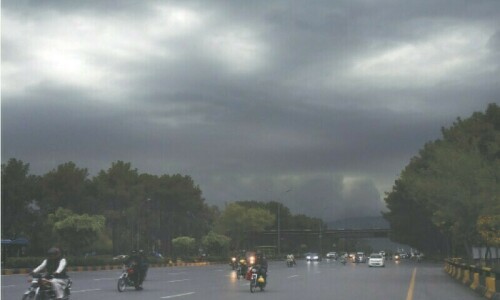UNITED NATIONS: In the last quarter of 2022, 8.6m in rural districts of three provinces of Pakistan faced a serious food crisis as one of the worst monsoon floods in years hit the country, said a UN-backed report released this week.
Of these people, 5.2 million were in nine districts of Sindh, 1.8m in seven districts of Khyber Pakhtunkhwa and 1.6m in 12 districts of Balochistan.
The latest global report on food crises, released by UN agencies on Thursday, warned that roughly 258m people in 58 countries faced acute hunger at crisis levels. And people in seven countries — Somalia, South Sudan, Yemen, Afghanistan, Nigeria, Haiti, and Burkina Faso — faced potential starvation.
This is the highest number in the seven-year history of the report, although much of the growth reflects an increase in the population analysed.
In Pakistan, the increase in severity, from 25 per cent to 43pc, “indicates a significantly deteriorating situation in all provinces, especially in Sindh, where five areas that were previously classified as in crisis shifted to emergency,” the report warns.
New report states roughly 258m people in 58 countries face food shortage at crisis levels
Overall, the share of the analysed population in crisis increased from 19pc to 30pc, while the proportion in emergency increased from 6pc to13pc.
Pakistan has been defined as a ‘major’ food crisis since 2017 when over 50pc of its analysed population was in phase three (crisis) or above.
Weather extremes
Even before Pakistan was hit by the devastating monsoon floods in mid-June and the end of August, heatwaves in March and April, in conjunction with fertiliser shortages and lack of irrigation water, had affected ‘Rabi’ wheat crop yields and lowered livestock production in most of the analysed districts.
Subsequently, flooding and landslides brought widespread destruction, disrupting the lives and livelihoods of about 33m people in five of six provinces.
Around 4.4m acres of agricultural land were damaged, prompting the downward revision of 2022 production forecasts for rice, maize, sorghum, and millet. Around 0.8m livestock were estimated to have perished.
The total damage and loss in the agriculture sector was estimated at almost $13bn, consisting mainly of crops (82pc) followed by livestock (17pc).
The October–December planting of the ‘Rabi’ wheat crop was hampered in localised areas that were still under flood water.
The loss or damage of agricultural inputs, including seed stocks, fertilisers, machinery and irrigation infrastructure, may result in a contraction in the area planted with a negative impact on 2023 production.
Strong domestic demand and high global commodity prices — largely linked to Covid-19-related disruptions and the war in Ukraine — led to the largest current account deficit in four years by the end of June 2022. The currency depreciated by 23.1pc against the US dollar and inflation reached an average of 12.2pc by the end of June, an 11-year high.
By August 2022, prices of wheat flour were about 30pc higher year-on-year and domestic prices of rice were at record levels.
Prices continued to increase until the end of the year and, by December 2022, the price of a basket of basic food items was 36pc higher year-on-year, the report noted.
A damage, loss and needs assessment estimated total flood damages to exceed $14.9bn, and total economic losses to reach about $15.2bn.
Due to higher domestic energy prices, flood disruptions, high agricultural input costs and the weaker rupee, inflation is projected to rise to 23pc in the year to the end of June 2023.
Published in Dawn, May 6th, 2023














































Dear visitor, the comments section is undergoing an overhaul and will return soon.